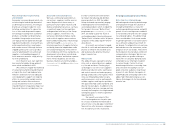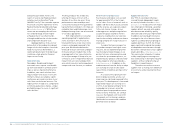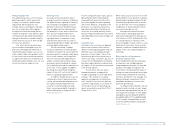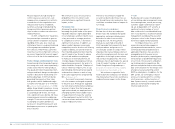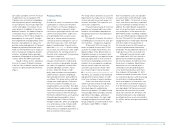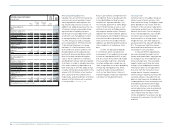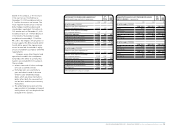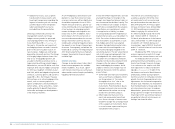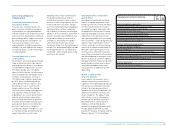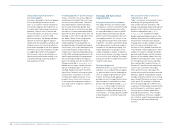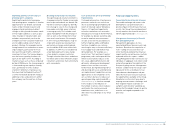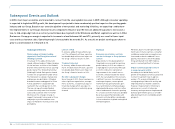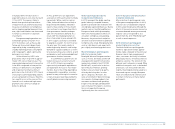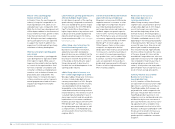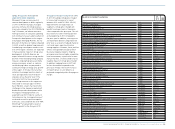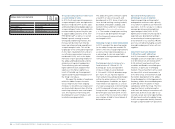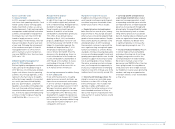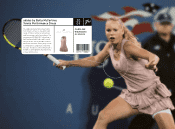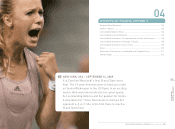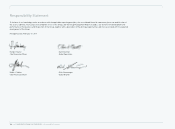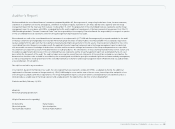Reebok 2009 Annual Report Download - page 159
Download and view the complete annual report
Please find page 159 of the 2009 Reebok annual report below. You can navigate through the pages in the report by either clicking on the pages listed below, or by using the keyword search tool below to find specific information within the annual report.
GROUP MANAGEMENT REPORT – FINANCIAL REVIEW Risk and Opportunity Report 155
Exploiting potential of new and fast-
growing sports categories
Exploiting the potential of emerging,
fast-growing sports categories is another
opportunity for our brands. Our brand
teams conduct market research and
engage in trend marketing to detect
changes in lifestyle and consumer needs
of their target audience as early as pos-
sible. Changes in lifestyle, habits and
attitudes can potentially result in the
emergence of new consumer needs that
are not addressed by current market
product offerings. For example, muscle
toning footwear has evolved into a mean-
ingful category, particularly for those
who want to keep fit with a minimum
investment of time. The toning category
was the fastest-growing footwear cat-
egory in the USA in 2009. According to
market surveys such as those conducted
by SportsONESource, the toning category
is forecasted to grow rapidly in coming
years, potentially to levels of about
one billion US dollars. Having success-
fully launched the Reebok EasyTone™
in 2009, the Reebok brand will introduce
additional styles and extensions within
this category over the next two to three
years.
Breaking new ground in distribution
The sporting goods retail environment is
changing constantly. People increasingly
want to get involved with our brands. We
therefore continue to adapt our distribu-
tion strategy to cater to this change and
have made controlled space initiatives
a strategic priority. This includes retail
space management with key retail part-
ners as well as the introduction of new
own-retail store formats. For example
in 2009, we launched Originals shop-in-
shops with several key retail partners
particularly in Europe and introduced
our first adidas SLVR store in New York.
In addition, in 2009 we also established
a new dedicated team to take charge
of our global e-commerce activities.
Through initiatives like these, we believe
we will be able to more effectively target
consumers and involve them emotionally
with our products.
Cost optimisation drives profitability
improvements
Continued optimisation of key business
processes and strict cost control are
vital to achieving high profitability and
return on invested capital. We believe
there is still significant opportunity
to further streamline cost structures
throughout our Group. In North America,
for example, we believe we will be able
to realise medium-term economies
of scale as we look for possibilities to
further integrate adidas and Reebok
functions. In addition, we continue
searching for ways to increase efficiency
in our supply chain and make it truly
demand-driven. For example, as a
result of our “Fast and Lean Creation”
programme, roles and responsibilities
will be restructured to reduce costly
non-value-added administration and
data entry, allowing our development
teams to focus on their core tasks.
Furthermore, by implementing end-to-
end planning processes and improving
our replenishment capabilities, we see
opportunities to not only better serve
our customers but also to reduce our
operating working capital needs see
Global Operations, p. 88. Another example
in this respect is the reduction of
the number of articles, which reduces
workload in the creation area and
warehouse costs, and allows us to
offer more focused ranges to our retail
partners.
Financial Opportunities
Favourable financial market changes
Favourable exchange and interest rate
developments can potentially have a
positive impact on the Group’s financial
results. Our Group Treasury department
closely monitors the financial markets to
identify opportunities see Treasury, p. 128.
Management Assessment of Overall
Risk and Opportunities
Management aggregates all risks
reported by different business units and
functions. Based on the compilation of
risks – taking into account the occur-
rence likelihood and potential financial
impact and the current business outlook
explained within this report – adidas
Group Management does not foresee any
individual or aggregate risks which could
materially jeopardise the viability of the
Group as a going concern. Management
remains confident that the Group’s earn-
ings power forms a solid basis for our
future business development and pro-
vides the necessary resource to pursue
the opportunities available to the Group.
Nonetheless, in the short term, due to
ongoing macroeconomic challenges and
their negative impact on private con-
sumption and consumer spending, we
believe that the adidas Group risk profile
remains unchanged compared to the
prior year.


